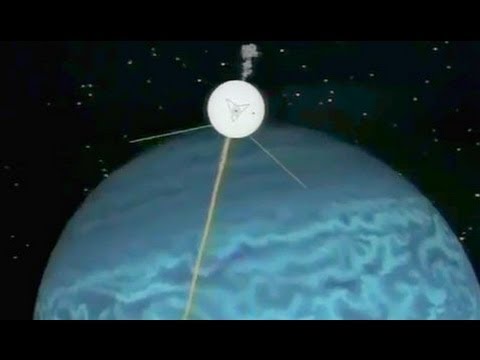more at
“This video describes Voyager 2’s encounter with Neptune. Computer animation and actual data convey Voyager’s discoveries such as turbulent storms and dark spots in Neptune’s atmosphere, six new moons, Neptune’s three rings, and the presence of frozen methane on Triton, as researchers at NASA’s Jet Propulsion Laboratory describe Voyager’s achievements”
Public domain film from NASA, slightly cropped to remove uneven edges, with the aspect ratio corrected, and mild video noise reduction applied.
The soundtrack was also processed with volume normalization, noise reduction, clipping reduction, and/or equalization.
The Voyager 2 spacecraft is a 722 kg (1,590 lb) space probe launched by NASA on August 20, 1977 to study the outer Solar System and eventually interstellar space. It was actually launched before Voyager 1, but Voyager 1 moved faster and eventually passed it. It has been operating for 35 years, 2 months and 12 days as of today (1 November 2012), the spacecraft still receives and transmits data via the Deep Space Network. At a distance of 99.1 AU (1.48×1010 km; 9.21×109 mi) as of September 2012, it is one of the most distant manmade objects (along with Voyager 1, Pioneer 10 and Pioneer 11).
Voyager 2 is part of the Voyager program with its identical sister craft Voyager 1, and is in extended mission, tasked with locating and studying the boundaries of the Solar System, including the Kuiper belt, the heliosphere and interstellar space.The primary mission ended December 31, 1989 after encountering the Jovian system in 1979, Saturnian system in 1980, Uranian system in 1986, and the Neptunian system in 1989. It is still the only spacecraft to have visited the two outer gas giant planets Uranus and Neptune…
Encounter with Neptune
Voyager 2’s closest approach to Neptune occurred on August 25, 1989. Since this was the last planet of our Solar System that Voyager 2 could visit, the Chief Project Scientist, his staff members, and the flight controllers decided to also perform a close fly-by of Triton, the larger of Neptune’s two originally known moons, so as to gather as much information on Neptune and Triton as possible, regardless of what angle at which Voyager 2 would fly away from Neptune. This was just like the case of Voyager 1’s encounters with Saturn and its massive moon Titan.
Through repeated computerized test simulations of trajectories through the Neptunian system conducted in advance, flight controllers determined the best way to route Voyager 2 through the Neptune-Triton system. Since the plane of the orbit of Triton is tilted significantly with respect to the plane of the ecliptic, through mid-course corrections, Voyager 2 was directed into a path several thousand miles over the north pole of Neptune. At that time, Triton was behind and below (south of) Neptune (at an angle of about 25 degrees below the Ecliptic), close to the apoapsis of its elliptical orbit. The gravitational pull of Neptune bent the trajectory of Voyager 2 down in the direction of Triton. In less than 24 hours, Voyager 2 traversed the distance between Neptune and Triton, and then observed the northern hemisphere of Triton as it passed over the moon’s north pole.
The net and final effect on the trajectory of Voyager 2 was to bend its trajectory south below the plane of the Ecliptic by about 30 degrees. Voyager 2 is on this path permanently, and hence, it is exploring space south of the plane of the Ecliptic, measuring magnetic fields, charged particles, etc., there, and sending the measurements back to the Earth via telemetry.
While in the neighborhood of Neptune, Voyager 2 discovered the “Great Dark Spot”, which has since disappeared, according to observations by the Hubble Space Telescope. Originally thought to be a large cloud itself, the “Great Dark Spot” was later hypothesized to be a hole in the visible cloud deck of Neptune.
Neptune’s atmosphere consists of hydrogen, helium, and methane. The methane in Neptune’s upper atmosphere absorbs the red light from the Sun, but it reflects the blue light from the Sun back into space. This is why Neptune looks blue.
With the decision of the International Astronomical Union to reclassify Pluto as a “plutoid” in 2008, the flyby of Neptune by Voyager 2 in 1989 became the point when every known planet in the Solar System had been visited at least once by a space probe…
Neptune is the eighth and farthest planet from the Sun in the Solar System. It is the fourth-largest planet by diameter and the third-largest by mass. Neptune is 17 times the mass of Earth and is somewhat more massive than its near-twin Uranus, which is 15 times the mass of Earth but not as dense. On average, Neptune orbits the Sun at a distance of 30.1 AU, approximately 30 times the Earth–Sun distance…

